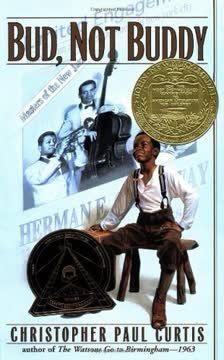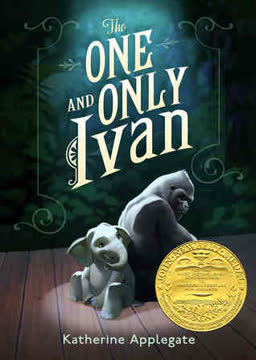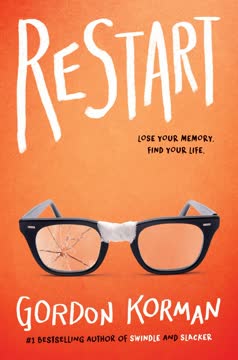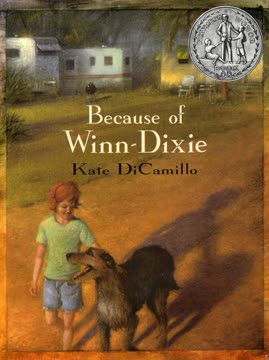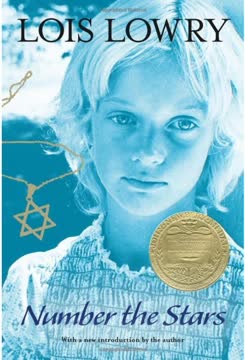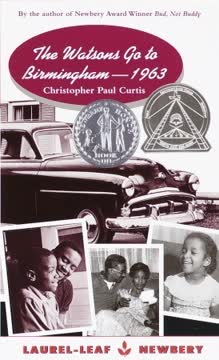Plot Summary
Orphaned Again, On the Move
Ten-year-old Bud Caldwell, orphaned after his mother's death, is shuffled from the Home to yet another foster family in Depression-era Flint, Michigan. Used to disappointment and loss, Bud clings to his battered suitcase, filled with mementos and clues about his past. The world is harsh for a Black child alone, and Bud's only armor is his wit, his "Rules and Things for Having a Funner Life and Making a Better Liar Out of Yourself," and the hope that somewhere, he belongs.
The Amos Family's Betrayal
Bud's new foster home with the Amos family quickly becomes a nightmare. Todd, the Amos' son, bullies Bud, and Mrs. Amos believes her own son's lies over Bud's truth. After a violent altercation, Bud is locked in a dark, terrifying shed for the night, accused and abandoned. The betrayal cements Bud's distrust of adults and his resolve to rely on himself.
Locked in the Night Shed
Alone in the shed, Bud's imagination conjures monsters—vampire bats, fish-head guards, and the ghosts of children before him. When hornets attack, Bud's terror becomes real, but his quick thinking and determination help him escape through a window. The ordeal is a test of his resourcefulness and resilience, reinforcing his belief in his own rules for survival.
Escape and Sweet Revenge
Bud sneaks back into the Amos house, retrieves his suitcase, and enacts a harmless but satisfying revenge on Todd. He pours warm water on Todd's hand, ensuring the bully will wet the bed. Bud then flees into the night, officially "on the lam," and heads for the only place he feels safe: the public library.
Library Sanctuary and Lost Hopes
The library is Bud's sanctuary, a place of order and knowledge. He searches for Miss Hill, a librarian he trusts, only to learn she has moved to Chicago. The loss of this connection is a blow, but Bud's curiosity and love of books offer comfort. He spends the night under a Christmas tree outside, clutching his suitcase and memories.
Bud's Rules for Survival
Throughout his journey, Bud relies on his self-made rules—practical, humorous, and poignant. These rules help him interpret adult behavior, avoid danger, and maintain hope. They are both a coping mechanism and a testament to his intelligence and adaptability in a world that offers little protection.
The Mission and Pretend Family
Desperate for food, Bud tries to get into the mission's breakfast line. A kind family pretends he is their son, "Clarence," allowing him to eat. The experience is bittersweet: Bud is grateful for their help but reminded of his own loneliness and longing for real family. The mission's rules and the sign "There's No Place Like America Today!" highlight the era's irony and hardship.
Hooverville's Lessons and Goodbyes
Bud and his friend Bugs find their way to Hooverville, a shantytown of the homeless and jobless. Here, Bud meets Deza Malone, who offers friendship and a first kiss. The community's solidarity and struggles teach Bud about dignity and survival. When the police destroy Hooverville and Bud misses the train west, he is forced to reconsider his path.
On the Lam with Bugs
Bugs and Bud become "brothers" and plan to ride the rails west in search of work and a new life. Their bond is cemented with a spit handshake, but fate intervenes. Bud misses the train, and Bugs is carried away, leaving Bud alone once more. The episode underscores the unpredictability of life and the pain of separation.
The Train, the Missed Chance
Bud's missed opportunity to escape on the train is a turning point. He is left behind as the police raid Hooverville, and the shantytown burns. Bud's blue flyer—an advertisement for Herman E. Calloway and his band—returns to him, reigniting his hope that Calloway is his father. Bud decides to walk to Grand Rapids to find him.
The Long Walk to Grand Rapids
Bud embarks on a grueling journey, walking alone at night toward Grand Rapids. He is picked up by Lefty Lewis, a kind but mysterious man who offers food, shelter, and a ride. Bud, ever cautious, invents stories to protect himself, but Lefty's genuine care and humor begin to break through Bud's defenses.
Lefty Lewis: A Ride and a Lie
Lefty Lewis, a Pullman porter and labor organizer, takes Bud to his daughter's home in Flint. Bud experiences warmth, laughter, and a sense of family with the Sleets. Lefty delivers Bud to Grand Rapids, sending a telegram to Herman E. Calloway. Bud's journey is shaped by the kindness of strangers and the realities of Black life during the Depression.
The Log Cabin and the Band
At the Log Cabin, Bud meets Herman E. Calloway and his band, the Dusky Devastators of the Depression. Bud announces that Calloway is his father, but the old man is gruff and dismissive. The band, especially Mr. Jimmy and Miss Thomas, show Bud compassion, inviting him to dinner and offering a glimpse of belonging.
Confronting Herman E. Calloway
Bud's insistence that Calloway is his father is met with disbelief and anger. The band members are curious and kind, but Calloway remains distant and suspicious. Bud's presence stirs painful memories, and the truth of their connection remains hidden beneath layers of grief and misunderstanding.
The Sweet Pea and New Belonging
At the Sweet Pea restaurant, Bud is welcomed by the band and Miss Thomas. He experiences joy, laughter, and the healing power of music. Overwhelmed by emotion, Bud cries for the first time in years, comforted by Miss Thomas. The band gives him a nickname, "Sleepy LaBone," and a sense of identity and home begins to take root.
Grand Calloway Station's Secrets
Bud is given a room in Calloway's house, "Grand Calloway Station," filled with relics of the past. He learns about the little girl whose room he occupies—his own mother, Angela. The house is a place of sorrow and hope, haunted by loss but alive with music and possibility.
Rocks, Revelations, and Family
Bud discovers that the rocks he carries, inscribed with dates and places, match those collected by Calloway. The revelation that Bud's mother was Calloway's daughter—making Calloway his grandfather—shatters the old man. Grief and regret overwhelm Calloway, but the truth allows Bud to finally understand his place in the world.
A New Name, A New Song
Bud is embraced by the band, given a saxophone, and a new name. He lets go of his suitcase's burdens, placing his mother's picture among her childhood horses. As Bud practices his first notes, he feels doors opening—toward healing, family, and a future filled with music and love.
Characters
Bud Caldwell
Bud is a ten-year-old African American boy orphaned in Depression-era Michigan. His mother's death leaves him rootless, but he is fiercely intelligent, resourceful, and guided by his self-made rules for survival. Bud's journey is both physical and emotional: he seeks family, identity, and a sense of belonging. His suitcase, filled with mementos, is a symbol of his hope and his past. Bud's psychological resilience is remarkable; he uses humor, imagination, and determination to navigate a world that is often hostile and indifferent. Over the course of the story, Bud transforms from a wary, lonely child into a young man with a new family, a new name, and a future.
Herman E. Calloway
Calloway is a legendary bandleader, known for his stern demeanor and high standards. He is haunted by the loss of his daughter, Angela, and has built emotional walls to protect himself from further pain. Calloway's collection of rocks, each inscribed with a date and place, is a private memorial to his daughter. When Bud appears, Calloway's grief and regret are reignited, leading to anger, denial, and ultimately, a painful reckoning. His journey is one of reluctant acceptance and the rediscovery of love through his grandson.
Miss Thomas
Miss Thomas is the band's singer and the emotional heart of Grand Calloway Station. She immediately recognizes Bud's need for care and belonging, offering him comfort, guidance, and a sense of home. Miss Thomas is perceptive, understanding both Bud's pain and Calloway's grief. She helps bridge the gap between them, advocating for patience, healing, and the power of chosen family.
Mr. Jimmy
Mr. Jimmy is Calloway's longtime friend and bandmate. He is practical, compassionate, and serves as a mediator within the group. Mr. Jimmy is quick to see Bud's potential and is instrumental in uncovering the truth about Bud's family. He represents stability and the importance of community.
Steady Eddie
Steady Eddie is the band's saxophonist and becomes Bud's mentor. He gifts Bud a saxophone and encourages his musical growth, symbolizing the passing of legacy and the creation of new dreams. Steady Eddie's kindness and humor help Bud feel accepted and valued.
Bugs
Bugs is Bud's best friend from the Home, known for his nickname (earned after a cockroach incident). He is adventurous, optimistic, and shares Bud's longing for escape and family. Their bond is deep, but circumstances separate them, highlighting the transient nature of relationships during hard times.
Deza Malone
Deza is a girl Bud meets in Hooverville. She is wise beyond her years, offering Bud both friendship and a gentle challenge to his emotional defenses. Their brief connection is a poignant reminder of the importance of kindness and the pain of separation.
Lefty Lewis
Lefty Lewis is a Pullman porter and labor organizer who helps Bud on his journey. He provides food, shelter, and a safe passage to Grand Rapids. Lefty's warmth and humor contrast with Bud's previous experiences, showing the impact of adult kindness.
The Amos Family
The Amoses are Bud's foster family, embodying the failures of the foster care system. Todd is a bully, and Mrs. Amos is quick to judge and punish Bud. Their betrayal and cruelty reinforce Bud's mistrust of adults and his determination to find his own way.
The Dusky Devastators of the Depression
The band members—Thug, Doo-Doo Bug, Dirty Deed, and others—are a diverse, lively group who welcome Bud into their fold. They provide mentorship, laughter, and a sense of belonging, helping Bud heal and find his place in the world.
Plot Devices
Bud's Rules and Things
Bud's self-authored rules are a recurring device, offering insight into his psychology and the world he inhabits. The rules are practical, humorous, and poignant, reflecting Bud's need for control and meaning in a chaotic environment. They structure the narrative, foreshadow events, and reveal Bud's growth as he adapts to new challenges.
The Suitcase and Its Contents
Bud's suitcase is a physical and emotional anchor, containing mementos of his mother and clues to his past. The suitcase's contents—rocks, flyers, a photograph—drive the plot and symbolize Bud's longing for connection and understanding. The act of unpacking the suitcase parallels Bud's journey toward self-discovery and acceptance.
The Blue Flyer
The blue flyer advertising Herman E. Calloway's band is Bud's link to his imagined father. It motivates his journey and serves as a tangible representation of hope. The flyer's return to Bud after the missed train is a moment of fate, redirecting his path and reinforcing the theme of destiny.
Music and Performance
Music is both backdrop and lifeblood in the novel. The band's performances provide joy, unity, and a sense of purpose. For Bud, learning to play the saxophone is a rite of passage, a way to honor his mother's memory and forge a new identity. Music bridges generational and emotional gaps, offering healing and belonging.
Foreshadowing and Narrative Structure
The narrative is rich with foreshadowing—Bud's rules, the recurring motif of doors closing and opening, and the rocks' inscriptions all hint at future revelations. The story's structure mirrors Bud's journey: each setback leads to a new opportunity, and each loss is met with unexpected kindness. The circularity of Bud's experiences—leaving, searching, finding—emphasizes resilience and hope.
Analysis
Bud, Not Buddy is a masterful blend of historical realism, humor, and emotional depth, offering a child's-eye view of the Great Depression while exploring universal themes of loss, resilience, and the search for belonging. Christopher Paul Curtis crafts a protagonist whose intelligence, wit, and vulnerability make him both relatable and inspiring. The novel critiques the failures of social systems—foster care, poverty, racism—while celebrating the power of community, music, and chosen family. Bud's journey is not just a physical quest for a father, but a psychological odyssey toward self-acceptance and healing. The story's enduring lesson is that family can be found in unexpected places, and that hope, humor, and kindness are essential tools for survival. In a world marked by hardship, Bud's voice reminds us that even the smallest seed of hope can grow into a mighty tree.
Last updated:
FAQ
Synopsis & Basic Details
What is Bud, Not Buddy about?
- A Young Boy's Quest: Ten-year-old Bud Caldwell, an orphan in Depression-era Flint, Michigan, embarks on a determined journey to find his biological father, armed only with a tattered suitcase of clues and his self-made "Rules and Things". His quest is driven by a deep longing for family and belonging after the death of his mother.
- Survival in Hard Times: The story chronicles Bud's escape from a cruel foster home and his encounters with various individuals and communities, including a Hooverville shantytown and a kind-hearted Pullman porter, all while navigating the harsh realities of poverty, racism, and transience during the Great Depression.
- The Power of Hope: Bud's journey is a testament to resilience, imagination, and the enduring human need for connection. He follows a series of flyers advertising a jazz band, believing its leader, Herman E. Calloway, to be his father, leading him to Grand Rapids and an unexpected discovery of family.
Why should I read Bud, Not Buddy?
- Heartwarming Resilience: Readers should experience Bud's remarkable resilience and unwavering optimism in the face of profound hardship, offering a powerful message about hope and perseverance. His unique narrative voice, filled with humor and wisdom beyond his years, makes his journey deeply engaging and inspiring.
- Historical Immersion: The novel provides a vivid, accessible, and often poignant glimpse into the realities of the Great Depression, particularly for African Americans, through the eyes of a child. It educates readers about Hoovervilles, labor movements, and the challenges of the era without being didactic.
- Universal Themes: Beyond its historical setting, the book explores universal themes of family, identity, loss, and the search for belonging. It celebrates the idea that family can be found in unexpected places and that love and community are essential for healing and growth, making it a timeless and emotionally resonant read.
What is the background of Bud, Not Buddy?
- Great Depression Setting: The story is set in 1936, during the height of the Great Depression, a period of immense economic hardship in the United States. This historical context explains the widespread poverty, the existence of Hoovervilles (shantytowns), and the struggles faced by many, especially African Americans, in finding work and stable homes.
- Author's Family Inspiration: Christopher Paul Curtis drew heavily from his own family history, basing the characters of Herman E. Calloway and Lefty Lewis loosely on his grandfathers. This personal connection imbues the narrative with authenticity and a deep understanding of the experiences of Black men and women during this challenging era, as detailed in the Afterword.
- Cultural Significance: The novel highlights the vibrant African American culture of the time, particularly through the jazz band, "Herman E. Calloway and the Dusky Devastators of the Depression." It showcases the resilience, creativity, and community spirit that thrived despite systemic racism and economic oppression, offering a nuanced portrayal of Black life in the 1930s.
What are the most memorable quotes in Bud, Not Buddy?
- "It's Bud, not Buddy, ma'am.": This iconic line, repeated throughout the novel, immediately establishes Bud's fierce assertion of his identity and autonomy. It underscores his need for respect and control in a world where he often feels powerless, setting the stage for his journey of self-discovery and the importance of his chosen name.
- "When one door closes, don't worry, because another door opens.": This advice from Bud's mother, initially misunderstood as literal, becomes a profound thematic motif representing resilience and hope. It guides Bud through every setback, transforming each closed door (foster homes, missed trains) into an opportunity for a new beginning and a step closer to his true family.
- "There comes a time when you're doing something and you realize it just doesn't make any sense to keep on doing it, you ain't being a quitter, it's just that the good Lord has seen fit to give you the sense to know, you understand, enough is enough.": Spoken by both Bud (after his fight with Todd) and Herman E. Calloway (about his boxing career), this parallel thought subtly foreshadows their familial connection. It highlights a shared philosophy of knowing when to pivot, emphasizing wisdom over stubbornness and marking a pivotal moment in their respective journeys.
What writing style, narrative choices, and literary techniques does Christopher Paul Curtis use?
- First-Person Child Narrator: The story is told from Bud's perspective, using a distinct, colloquial, and often humorous voice that captures the innocence and wisdom of a ten-year-old. This narrative choice allows readers to experience the harsh realities of the Depression through a lens of resilience and imagination, making complex themes accessible and emotionally resonant.
- "Rules and Things" as a Structural Device: Bud's self-created "Rules and Things for Having a Funner Life and Making a Better Liar Out of Yourself" serve as both a coping mechanism and a unique literary device. These numbered rules provide comic relief, foreshadow events, and offer insight into Bud's psychological state and his understanding of the adult world, structuring his observations and decisions.
- Vivid Sensory Details and Metaphorical Language: Curtis employs rich sensory descriptions, particularly of smells (the library, the Sweet Pea restaurant) and sounds (Miss Thomas's humming, the band's music), to immerse the reader in Bud's world. He also uses imaginative metaphors, such as the "mighty maple" idea for Bud's growing conviction about his father, to convey complex emotions and abstract concepts in a child-friendly manner.
Hidden Details & Subtle Connections
What are some minor details that add significant meaning?
- The Smell of the Library: Bud describes the library's unique scent as a blend of "leather on all the old books," "cloth that covered the brand-new books," and "soft, powdery, drowsy smell" of pages, which he calls a "hypnotizing smell." This detail symbolizes the library as a sanctuary and a source of escape, knowledge, and comfort, a place where time seems to slow down and worries fade, contrasting sharply with the chaotic world outside.
- Lefty Lewis's "Red Pop": The red pop offered by Lefty Lewis is more than just a drink; it becomes a symbol of unexpected kindness and a moment of pure, unadulterated joy for Bud. Its "reddest red in the world" appearance, shining through the taillights, highlights the vividness of this small pleasure amidst Bud's hunger and fear, marking a turning point in his trust of adults.
- Calloway's Band Names: The various names of Herman E. Calloway's band on the flyers—"Dusky Devastators of the Depression," "Nubian Knights of the New Deal," "Terminally Unhappy Blues Band," "Gifted Gents of Gospel"—subtly reflect the band's versatility, the historical context, and Calloway's evolving identity or aspirations. They hint at the different facets of his musical journey and the challenges faced by Black musicians during the era.
What are some subtle foreshadowing and callbacks?
- Momma's "Another Door Opens": Bud's mother's repeated saying, "when one door closes, don't worry, because another door opens," is a constant callback that subtly foreshadows Bud's entire journey. Each setback, from leaving the Home to missing the train, is framed as a closed door leading to a new, often better, opportunity, culminating in his acceptance into the Calloway family.
- Calloway's "Enough is Enough" Philosophy: Herman E. Calloway's story about quitting boxing because "it just doesn't make any sense to keep on doing it... enough is enough" directly mirrors Bud's own thought process when he gives up fighting Todd Amos. This shared philosophy, expressed in almost identical words, is a powerful, subtle hint at their biological connection long before the truth is revealed.
- The Inscribed Rocks: The rocks Bud carries, inscribed with dates and locations, are initially just sentimental objects from his mother. The later revelation that Herman E. Calloway collects similar rocks, each marking a performance location and date for his daughter, serves as the ultimate, undeniable piece of foreshadowing, directly leading to the discovery of their familial bond.
What are some unexpected character connections?
- Lefty Lewis's Labor Activism: Lefty Lewis, initially appearing as a kind stranger, is revealed to be a labor organizer for the Pullman porters, distributing flyers for a union meeting. This connects Bud's personal quest for belonging to the broader struggle for dignity and rights for African American workers during the Depression, showing how individual lives are intertwined with larger social movements.
- The Band as a Chosen Family: While Bud is searching for his biological father, the band members (Steady Eddie, Mr. Jimmy, Thug, Dirty Deed, Doo-Doo Bug) quickly form an unexpected surrogate family. Their teasing, mentorship, and genuine care for Bud, culminating in the gift of a saxophone and a new nickname, highlight the theme that family extends beyond blood ties and can be found in community.
- Miss Thomas's Maternal Role: Miss Thomas, the band's vocalist, immediately steps into a nurturing, maternal role for Bud, offering comfort and emotional support that Herman E. Calloway cannot. Her intuitive understanding of Bud's needs and her ability to soothe him with her humming establish her as a crucial emotional anchor, bridging the gap between Bud's past loss and his future family.
Who are the most significant supporting characters?
- Lefty Lewis: The Compassionate Bridge: Lefty Lewis is pivotal as the first adult who genuinely helps Bud without ulterior motives, providing safe passage and a temporary home. His role as a labor organizer also subtly introduces Bud to the concept of collective action and dignity, broadening Bud's understanding of the world beyond his personal struggles and directly connecting him to Herman E. Calloway.
- Miss Thomas: The Emotional Healer: Miss Thomas serves as the emotional heart of the Calloway household and the band. Her immediate warmth, empathy, and ability to recognize Bud's deep-seated pain (leading to his first tears in years) are crucial for Bud's psychological healing. She acts as a mediator between Bud and the gruff Herman, advocating for Bud and helping to uncover the truth about his mother.
- Steady Eddie: The Mentor and Gifter of Legacy: Steady Eddie, the saxophonist, becomes Bud's primary mentor within the band, offering encouragement, a new nickname ("Sleepy LaBone"), and the gift of a saxophone. He represents the passing of a musical legacy and a new path for Bud, symbolizing acceptance and the opportunity for Bud to find his own voice and place within the family.
Psychological, Emotional, & Relational Analysis
What are some unspoken motivations of the characters?
- Herman E. Calloway's Gruff Exterior: Calloway's initial harshness and suspicion towards Bud are an unspoken defense mechanism, motivated by profound, unaddressed grief over his daughter, Angela. He has built emotional walls to protect himself from further pain, making him resistant to new attachments and unknowingly pushing away the very connection he unknowingly longs for.
- Bud's Constant Lying: Bud's "Rules and Things for Having a Funner Life and Making a Better Liar Out of Yourself" reveal an unspoken motivation for self-preservation and control. His lies are not malicious but a sophisticated coping strategy developed to navigate unpredictable and often hostile adult environments, allowing him to manipulate situations to his advantage and protect his vulnerable self.
- Miss Thomas's Immediate Nurturing: Miss Thomas's instant, deep compassion for Bud, evident in her gentle touch and comforting words, stems from her unspoken understanding of loss and her own maternal instincts. Her immediate recognition of Bud's emotional needs suggests she may have experienced similar pain or longed for a child, making her a natural source of healing and acceptance for Bud.
What psychological complexities do the characters exhibit?
- Bud's Emotional Suppression and Resilience: Bud exhibits a complex psychological state of suppressed grief and forced maturity. His repeated assertion that "my eyes don't cry no more" highlights his coping mechanism of emotional detachment, yet his vivid imagination and "Rules" demonstrate a deep internal life and remarkable resilience. His eventual breakdown at the Sweet Pea signifies a crucial release of pent-up emotion, a step towards genuine healing.
- Herman E. Calloway's Grief and Control: Herman E. Calloway is a psychologically complex character, driven by unacknowledged grief and a need for control. His meticulous collection of rocks, each a memorial to his daughter, reveals a deep, hidden sorrow beneath his gruff exterior. His inability to express emotion openly and his strictness are manifestations of his pain, making him initially blind to the familial connection right in front of him.
- The Amoses' Projection and Prejudice: The Amos family, particularly Mrs. Amos, displays psychological complexities rooted in prejudice and a need to maintain social standing. Their quickness to believe Todd's lies and their harsh treatment of Bud reflect their own insecurities and a desire to project their perceived failures onto an vulnerable outsider, highlighting the psychological toll of societal biases during the Depression.
What are the major emotional turning points?
- Bud's First Tears at the Sweet Pea: The most significant emotional turning point for Bud occurs at the Sweet Pea restaurant when, overwhelmed by the band's music and Miss Thomas's kindness, he cries for the first time in years. This moment, described as a "rusty old valve squeaked open," signifies the breaking of his emotional dam, allowing him to process years of suppressed grief and truly begin to heal.
- Herman E. Calloway's Breakdown: Herman E. Calloway's emotional collapse upon realizing Bud is his grandson, triggered by the inscribed rocks and Angela's name, is a profound turning point for him. His "bawling his eyes out" in his daughter's room reveals the depth of his long-held grief and regret, shattering his gruff facade and opening the door for a genuine connection with Bud.
- Deza Malone's Insight into Family: Bud's conversation with Deza Malone in Hooverville, where she tells him, "I guess you sort of carry your family around inside of you," is an emotional turning point that shifts Bud's understanding of family. This insight helps him realize that his mother's love and presence are internal, not just external, preparing him for the complex reality of finding his grandfather.
How do relationship dynamics evolve?
- Bud and Herman E. Calloway: From Antagonism to Acceptance: Their relationship evolves from initial suspicion and outright denial to a grudging, then deeply emotional, acceptance. Calloway's gruffness slowly gives way to a recognition of shared traits and, finally, overwhelming grief and love upon learning Bud is his grandson. Bud, in turn, moves from seeking a heroic father figure to accepting a flawed but loving grandfather.
- Bud and the Band: From Strangers to Surrogate Family: The band members initially view Bud with curiosity, but their interactions quickly foster a sense of belonging. They transition from being "Dusky Devastators" to a supportive, teasing, and mentoring "family," culminating in their gift of a saxophone and a new name, "Sleepy LaBone," solidifying Bud's place within their community.
- Bud and Miss Thomas: A Maternal Bond Forms: Miss Thomas's relationship with Bud develops rapidly into a strong maternal bond. She immediately offers him the comfort and emotional security he has lacked, becoming a surrogate mother figure. Her intuitive understanding and gentle guidance help Bud navigate his complex emotions and bridge the gap between him and his grandfather, demonstrating the power of chosen family.
Interpretation & Debate
Which parts of the story remain ambiguous or open-ended?
- The Exact Circumstances of Angela's Departure: While Miss Thomas explains that Angela left due to Herman E. Calloway's overbearing nature and desire for her to attend college, the full emotional depth and specific events leading to her running off with a drummer remain somewhat ambiguous. This leaves room for readers to ponder the complexities of family conflict and the sacrifices made for personal freedom during that era.
- The Future of Hooverville Residents: The story concludes with Hooverville being violently dismantled by the police, leaving the fate of characters like Deza Malone and Bugs uncertain. This open-ended element reflects the harsh realities and transient nature of life during the Great Depression, prompting readers to consider the broader societal impact and the countless untold stories of those displaced.
- The Long-Term Impact of Bud's Trauma: While Bud experiences significant healing and finds a new family, the novel leaves open the long-term psychological impact of his early trauma, including his emotional suppression and the "Rules and Things". Readers might debate how these coping mechanisms will evolve as he grows older and whether he will fully shed the need for such defenses in his new, stable environment.
What are some debatable, controversial scenes or moments in Bud, Not Buddy?
- Bud's Revenge on Todd Amos: Bud's decision to pour warm water on Todd's hand to make him wet the bed is a debatable moment. While presented as a harmless, satisfying act of "sweet revenge" for the bullying and injustice he suffered, some might view it as perpetuating a cycle of mischief or question its moral implications, especially given Bud's otherwise principled nature.
- The Amoses' Treatment of Bud: The Amoses' cruelty, particularly Mrs. Amos's immediate belief in her son's lies and her racist remarks ("those members of our race who do not want to be uplifted"), is a controversial depiction of foster care. It sparks debate about the systemic failures and racial prejudices prevalent during the Depression, highlighting the vulnerability of Black children in such systems and challenging readers to confront uncomfortable truths.
- The Police Raid on Hooverville: The violent destruction of Hooverville by the police, including shooting holes in pots and pans and burning shacks, is a stark and controversial scene. It directly confronts the harsh realities of state power and the suppression of the poor and marginalized during the Depression, prompting discussions about social justice, property rights, and the government's role in times of crisis.
Bud, Not Buddy Ending Explained: How It Ends & What It Means
- A New Identity and Voice: The ending sees Bud fully embraced by Herman E. Calloway's band, receiving a new nickname, "Sleepy LaBone," and a saxophone. This signifies his acceptance into a chosen family and the discovery of his own voice and potential. The saxophone, initially a symbol of his mother's legacy, becomes his instrument for self-expression and a tangible link to his future in music, moving beyond his past burdens.
- The Culmination of "Doors Opening": Bud's mother's mantra, "when one door closes, another door opens," reaches its powerful culmination. His journey, marked by numerous closed doors (the Home, the Amoses, Hooverville, the missed train), finally leads him to the open door of Grand Calloway Station and a loving family. The final squeaks and squawks of his saxophone are interpreted as "the squeaks and squawks of one door closing and another one opening," symbolizing a hopeful new beginning.
- Healing and Legacy: The ending represents a profound healing for both Bud and Herman E. Calloway. Bud finds the family he desperately sought, and Calloway begins to process his long-suppressed grief over his daughter, Angela. By placing his mother's picture among her childhood horse images and keeping only the Flint rock, Bud acknowledges his internal connection to his mother while embracing his new life and the legacy of music and family.
Review Summary
Bud, Not Buddy is a heartwarming, humorous, and poignant story set during the Great Depression. Readers praise Curtis's authentic portrayal of 10-year-old Bud's voice and his journey to find family. The book skillfully balances humor with serious themes like racism and poverty. Many found it engaging and emotional, appreciating the historical context and Bud's determination. While some felt the plot was predictable, most readers, both children and adults, thoroughly enjoyed the book, highlighting its memorable characters and valuable life lessons.
Similar Books
Download PDF
Download EPUB
.epub digital book format is ideal for reading ebooks on phones, tablets, and e-readers.
